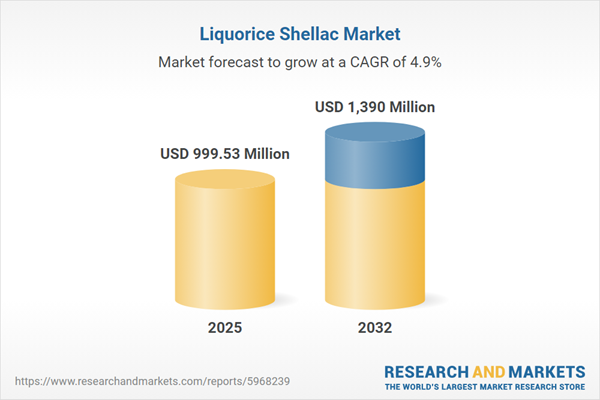Speak directly to the analyst to clarify any post sales queries you may have.
The liquorice shellac market is evolving rapidly, positioning itself as a strategic ingredient for manufacturers in cosmetics, food, pharmaceuticals, and wood finishing. Its natural origin, compliance ability, and compatibility with sustainable trends are moving it to the center of product innovation and operational value creation.
Market Snapshot: Liquorice Shellac Market Growth and Trajectory
The Liquorice Shellac Market grew from USD 953.43 million in 2024 to USD 999.53 million in 2025. It is expected to continue growing at a CAGR of 4.91%, reaching USD 1.39 billion by 2032. This consistent expansion highlights the resin’s relevance across diverse sectors and its capacity to address emerging consumer and industry demands. Leading factors include increasing demand for naturally derived additives, regulatory scrutiny on synthetic alternatives, and the critical role of traceability and sustainability throughout global supply chains.
Scope & Segmentation
This report comprehensively analyzes key growth levers, diverse end-use applications, and advances in processing, emphasizing core market drivers and emerging opportunities. Segmentation encompasses:
- Applications: Cosmetics (hair spray, nail polish, skin products), Food (bakery coatings, beverage coating, confectionery), Pharmaceuticals (capsule coating, liquid formulation, pill coating), Wood Finishing (floor coating, furniture coating, musical instruments)
- Product Form: Dry, Flake, Liquid
- End Use Industry: Cosmetics Production, Food Processing, Pharmaceuticals Manufacturing, Wood Treatment
- Distribution Channel: Direct Sales, Distributors, Offline Retail, Online Retail
- Grade: Food Grade, Industrial Grade, Pharma Grade
- Regional Coverage: Americas (North America, Latin America), Europe, Middle East & Africa, Asia-Pacific
- Company Analysis: Includes established firms and emerging market entrants such as Symrise AG, Givaudan SA, International Flavors & Fragrances Inc., A.M. Todd Co., Norquay LLC, Tokyo Chemical Industries Co., Indena S.p.A., A. Will & Co., Purity Shellac International Pvt. Ltd., Kraemer & Company, Inc.
Key Takeaways for Senior Decision-Makers
- Liquorice shellac’s multifunctional properties support advanced formulations in cosmetics, food, and pharma, underpinning product integrity and market differentiation strategies for manufacturers.
- Innovations in solvent-less extraction and encapsulation drive quality improvements and sustainability, critical for compliance and operational cost management in regulated industries.
- Regional players in Asia-Pacific and the Americas increasingly leverage domestic sourcing and technology transfer, achieving supply security and competitive pricing against international benchmarks.
- Strategic collaborations, including partnerships with research institutions and harvesting cooperatives, accelerate the development of tailored resin blends aligned with evolving regulatory and consumer requirements.
- Distribution channel shifts, notably the rise of online retail for niche manufacturers, are expanding access but also creating new demands for technical support and logistics optimization.
Tariff Impact on Supply Chains and Cost Structures
Recent United States tariffs on imported liquorice shellac raw materials have reconfigured procurement approaches and cost allocations for domestic manufacturers. The shift prompted these manufacturers to diversify sourcing, establish inventory buffers, and invest in regional processing facilities, thereby reducing exposure to cross-border duties. Adjustments in procurement are influencing pricing structures and motivating end-users to pursue local partnerships and alternative material blends to offset cost pressures and maintain compliance.
Methodology & Data Sources
Data for this report was derived from extensive primary research, including interviews with industry executives, technical experts, and procurement leaders. Field observations at processing sites provided validation of operational trends, while secondary sources such as regulatory filings and industry reports were triangulated against primary findings for accuracy. Analytical tools included market mapping, SWOT analysis, and segment modeling, ensuring insights reflect real conditions and business realities.
Why This Report Matters
- Enables decision-makers to identify critical supply chain vulnerabilities and recognize growth opportunities across emerging and mature market segments.
- Supports informed strategic planning by elucidating technology, regulatory, and procurement trends while presenting actionable recommendations to enhance resilience and value creation.
Conclusion
Liquorice shellac’s expanding footprint across high-growth sectors reflects its ongoing strategic importance. Industry participants prepared to adapt to regulatory changes and evolving supply dynamics will secure sustainable positions in a competitive landscape.
Additional Product Information:
- Purchase of this report includes 1 year online access with quarterly updates.
- This report can be updated on request. Please contact our Customer Experience team using the Ask a Question widget on our website.
Table of Contents
3. Executive Summary
4. Market Overview
7. Cumulative Impact of Artificial Intelligence 2025
Companies Mentioned
The companies profiled in this Liquorice Shellac market report include:- Symrise AG
- Givaudan SA
- International Flavors & Fragrances Inc.
- A.M. Todd Co.
- Norquay LLC
- Tokyo Chemical Industries Co., Ltd.
- Indena S.p.A.
- A. Will & Co., Inc.
- Purity Shellac International Pvt. Ltd.
- Kraemer & Company, Inc.
Table Information
| Report Attribute | Details |
|---|---|
| No. of Pages | 188 |
| Published | October 2025 |
| Forecast Period | 2025 - 2032 |
| Estimated Market Value ( USD | $ 999.53 Million |
| Forecasted Market Value ( USD | $ 1390 Million |
| Compound Annual Growth Rate | 4.9% |
| Regions Covered | Global |
| No. of Companies Mentioned | 11 |









